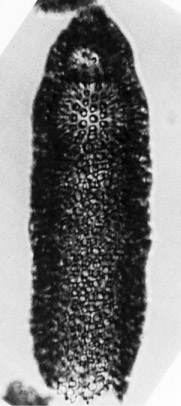 Phormocyrtis
cubensis (Riedel and Sanfilippo)
Phormocyrtis
cubensis (Riedel and Sanfilippo) Phormocyrtis
cubensis (Riedel and Sanfilippo)
Phormocyrtis
cubensis (Riedel and Sanfilippo)Eucyrtidium cubense Riedel and Sanfilippo, 1971, p.1594, pl.7, figs.10-11
Phormocyrtis cubensis (Riedel and Sanfilippo), Foreman, 1973, p.438, pl.7, figs.11-12, 14
Upper three segments form a conical section of the shell, and fourth segment (separated from third by slight if any internal ledge) approximately cylindrical. Cephalis subspherical, with few small pores, and bearing a short bladed apical spine. Collar stricture indistinct externally. Thorax campanulate and abdomen inflated annular, separated by pronounced internal and slight external lumbar stricture. Pores of both thorax and abdomen subcircular, larger and more closely spaced on the abdomen. In most specimens, longitudinal ridges on the surface of thorax and proximal part of abdomen separate longitudinal rows of pores. Fourth segment subcylindrical, of densely spongy material. Termination ragged or broken in all observed specimens (Riedel and Sanfilippo, 1971).
There are six collar pores, the two jugular pores very small, and an upwardly directed vertical pore emerging from the thoracic wall that envelopes the basal cephalis (Foreman, 1973).
Based on 9 specimens. Length of first three segments 120-150 µm, their maximum breadth 90-135 µm (Riedel and Sanfilippo, 1971).
This species differs from all other known multisegmented forms by the spongy nature of the fourth segment.
This species varies in the degree of inflation of the abdomen and the density of the spongy material covering the fourth segment.
This species is present in material from the tropical Pacific and Atlantic Oceans and from the Gulf of Mexico. Its morphotypic first appearance lies within the Bekoma campechensis Zone. Its morphotypic last appearance is approximately synchronous with the lower limit of the Phormocyrtis striata striata Zone.